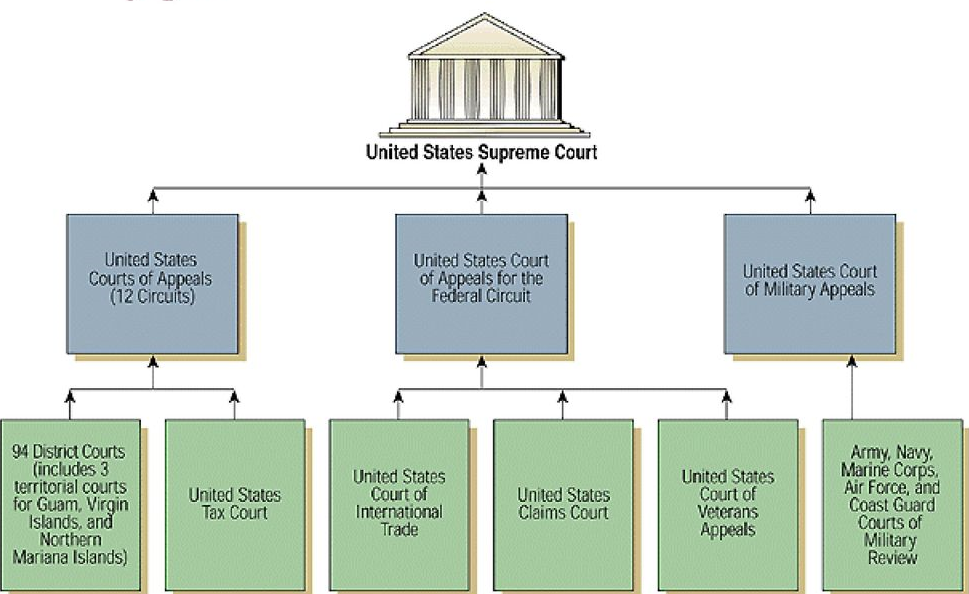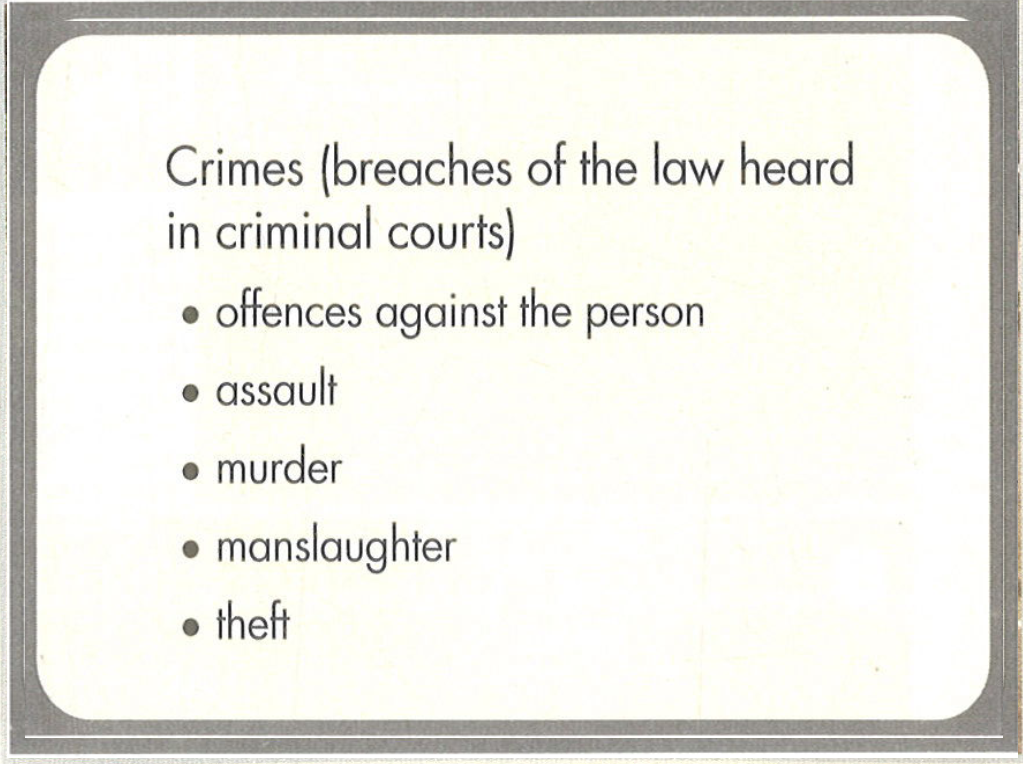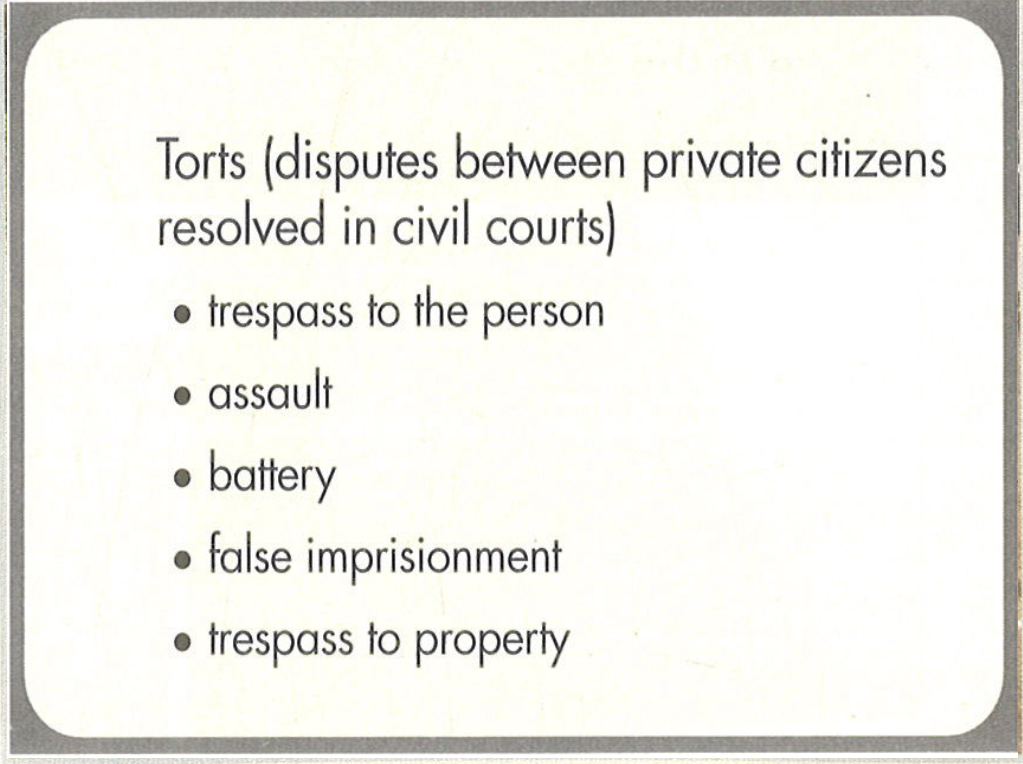Main content blocks
Section outline
-
This unit focuses on the court systems in more detail and outlines where different types of cases such as torts and crimes are most likely to be tried. By the end of this unit you should be able to:
-
-
- know the different types of courts;
- know how the court systems are structured in the United Kingdom and the United States of America;
- know the basic court orders and injunctions;
- explain the difference between tort and crime;
- know the various types of tort;
- know the basic crime categories;
- distinguish between torts and crimes.
-
-
Types of Courts
1. Small claims court /ˌsmɔːl ˈkleɪmz ˌkɔːt/ - A court that deals with disputes over small amounts of money.
E.g. They were of the view that such debts could be handled perfectly adequately through the small claims court in the first instance.
2. Court of Appeal (also called an Appeal Court / appellate court/ court of appeals/ appeals court) /kɔːt əv əˈpiːl/ - A civil or criminal court to which a person may go to ask for an award or sentence to be changed.
E.g. I think it would be much better to adopt the line of an international court of appeal.
3. Court-martial (n/v) /ˌkɔːt ˈmɑː.ʃəl/ - A court which tries someone serving in the armed forces for offences against military discipline.
E.g. I hardly think if somebody is acquitted he would elect to be tried by court-martial. She is likely to be court-martialled for disobeying her commanding officer.
4. County Court /ˌkaʊn. ti ˈkɔːt/ - One of the types of court in England and Wales and some parts of the USA which hears local civil cases. (There are about 270 County Courts in England and Wales. They are presided over by either district judges or circuit judges. They deal mainly with claims regarding money, but also deal with family matters, bankruptcies and claims concerning land).
E.g. I appreciate the arguments in favour of sending these cases to the county court.
5. The European Court of Human Rights (ECHR) /ðəˌjʊə. rəˈpiː.ən ˌkɔːt əv ˌhjuː.mən ˈraɪts/ also known as Strasbourg Court is a court which considers the rights of citizens of states which are parties to the European Convention for the Protection of Human Rights.
E.g. ECHR is taking a number of exceptional measures to respond to the unprecedented global health crisis, having regard to the recent decisions of the French authorities and the Council of Europe.
6. Employment tribunal /ɪmˈplɔɪ.mənt /traɪˈbjuː.nəl/ - A body responsible for hearing work-related complaints as specified by statute. (Formally, it is known as an industrial tribunal. The panel hearing each case consists of a legally qualified chairperson and two independent lay (= not legally qualified) people who have experience of employment issues. Decisions need to be enforced by a separate application to the court. Appeals are made to an Employment Appeal Tribunal)
E.g. Claims must be submitted to an employment tribunal within three month of the alleged act of discrimination.
7. Magistrates' court /ˈmædʒ.ɪ.streɪts ˌkɔːt/ - A court which hears cases of petty crime, adoption, affiliation, maintenance and violence in the home (= domestic violence), and which can also commit someone for trial or sentencing in a Crown Court.
E.g. The case was heard in a magistrates’ court.
8. Coroner's court /ˈkɒr.ə.nərz kɔːt/ - A court presided over by a public official (usually a doctor or lawyer) who investigates sudden, unexpected and violent deaths. (An investigation in a coroner's court is called a coroner's inquest. A coroner's inquest also decides what happens when treasure or something valuable that has been secretly hidden or lost is suddenly rediscovered).
E.g. The Coroner's Court is responsible to inquire into the causes and circumstances of some deaths.
9. Crown Court /ˌkraʊn ˈkɔːt/ - A court above the level of a magistrates' court which hears serious criminal cases, by a judge and a jury in the UK.
E.g. Crown Courts have power to deal with indictable offences, and also hear most appeals from magistrates’ courts.
10. Lands Tribunal /lændz traɪˈbjuː.nəl/ - A court which deals with compensation claims relating to land.
E.g. The Lands Tribunal resolves a range of disputes about the value of land and buildings, and about their occupation, use or development.
11. Commercial Court /kəˈmɜː.ʃəl ˌkɔːt/ - A court in the Queen's Bench Division (= one of the main divisions of the High Court) which hears cases relating to business disputes.
E.g. A commercial court judge ruled the company was wrong to terminate the contract.
12. Rent tribunal /rent traɪˈbjuː.nəl/ - A court which adjudicates in disputes about money paid or services provided in return for borrowing something – usually buildings or land.
E.g. The Rent Tribunal will need a copy of your tenancy contract (mandatory).
13. The High Court /ˌhaɪ ˈkɔːt/ - The main civil court in England and Wales. This is usually the highest court in jurisdiction, the court of last resort.
E.g. The financier could be more than £1m poorer after losing his High Court battle with his former company.
14. The European Court of Justice /ðəˌjʊə. rəˈpiː.ən ˌkɔːt əv dʒʌs.tɪs / - An organization of the European Union, formed of one judge from each member country, that decides on the laws that all its members should follow. It has the power to change decisions made by national courts. (ECJ – short form. It is also called the Court of Justice of the European Communities).
E.g. The ECJ set up to see that the principles of law as laid out in the Treaty of Rome are observed and applied correctly in the European Union.
15. Court of Protection /ˌkɔːt əv prəˈtek.ʃən/ - A court appointed to serve the interests of people who are not capable of dealing with their own affairs, such as patients who are mentally ill.
E.g. The Court of Protection in English law is a superior court of record created under the Mental Capacity Act 2005.
16. The Admiralty Court /ˈædmərəlti ˌkɔːt/ / - The court which is part of the Queen's Bench Division, which decides in disputes involving ships.
E.g. Historically, admiralty courts were a separate part of the court system.
17. The House of Lords /ˌhaʊs əv ˈlɔːdz/ - The highest court of appeal in the United Kingdom. Since 2009, it is known as the Supreme Court. (although appellants unhappy with a decision made here can appeal to the European Court of Justice).
E.g. The House of Lords is the United Kingdom's supreme court of appeal.
18. Juvenile court /ˈdʒuː.vən.aɪlˌkɔːt/ - A court where a person under the age of 18 would be tried.
E.g. The object of that requirement is to make sure that the local authority will put all its views and information before the juvenile court.
19. Lower court /ˈləʊ. ər kɔːt/ - A court of primary jurisdiction, where a case is heard for the first time and whose decisions can be appealed to a higher court.
E.g. The lower court found that evidence was circumstantial.
20. Moot court /muːt/ kɔːt/ - a mock court in which hypothetical cases are argued, usually as an academic exercise for law students.
E.g.The practical training for students is organized at courts of law, and local and international moot court competitions.
Remember:
A courthouse is the general word for a building in which trials take place.
-
This activity checks your understanding of the types of courts and the ability to decide which of the courts is most likely to deal with certain situations.
-
The Structure of the Courts in the UK The UK court system is complicated and – in places – confusing, because it has developed over 1,000 years rather than being designed from scratch.
Different types of case are dealt with in specific courts: for example, all criminal cases will start in the magistrates’ court, but the more serious criminal matters are committed (or sent) to the Crown Court. Appeals from the Crown Court will go to the High Court, and potentially to the Court of Appeal or even the Supreme Court.
Civil cases will sometimes be dealt with by magistrates, but may well go to a county court. Again, appeals will go to the High Court and then to the Court of Appeal – although to different divisions of those courts.
The tribunals system has its own structure for dealing with cases and appeals, but decisions from different chambers of the Upper Tribunal, and the Employment Appeals Tribunal, may also go to the Court of Appeal.
The courts structure covers England and Wales; the tribunals system covers England, Wales, and in some cases Northern Ireland and Scotland.

https://www.judiciary.uk/about-the-judiciary/the-justice-system/court-structure/
-
The American Court System
The United States has a unique court system in that it is divided between a federal system covering the whole country and independent systems in each state and US territory. The systems can cover the same grounds in criminal, civil and administrative law. For instance, there are both federal and state laws against murder, lawsuits can be brought by the same people against the same people in both state and federal court and both the federal and state government regulate things like securities and the environment. The running of these two parallel systems simultaneously on the state and federal levels is known as “federalism.”
The federal court system was established by Article 3 of the Constitution, but new judges and courts are established by Congress and the President. State court systems are established by state law or state constitution.
The details of the structure of the federal court system was the first order of business of the first US Congress, which passed the Judiciary Act of 1789 as Senate Bill 1. That Act created the federal judiciary system still in use today. The original federal judicial system consisted of a Supreme Court with six Justices, three appeals courts, each presided over by two Supreme Court justices and a district court judge and 13 trial courts, each presided over by a district judge.
Over the years, the numbers of courts and judges have changed with the growth and shifting of populations. Today, the federal judicial system consists of the Supreme Court with nine justices, thirteen circuit courts of appeal (11 geographic circuit courts, the D.C. Circuit court and the Federal Circuit) and 94 district courts. There are also a number of specialty courts of limited jurisdiction.[3]
The 94 district courts are scattered across the country, with each state and territory having between one and four districts. In districts with large populations, one district court may have offices, courtrooms and judges in multiple locations. For instance, the Northern District of Ohio court has locations in Cleveland, Toledo, Akron and Youngstown.[4] Each federal district also has a bankruptcy court.
Congress also created several “Article I,” or legislative courts, that do not have full judicial power. These include the Court of Appeals for Veterans Claims, the Court of Appeals for the Armed Forces and Tax Court.[5] There are also military courts and tribunals that are not part of the federal court system under Article III.

https://lawshelf.com/videocoursesmoduleview/the-american-court-system-module-1-of-5
-
Injunction /ɪnˈdʒʌŋkʃən/ - an official order given by a law court, usually to stop someone from doing something. https://dictionary.cambridge.org/dictionary/english/injunction
Choose the best word to complete the sentence and type it in the space provived. Be careful to spell it correctly, if it is written with a capital letter than you should also use a capital letter .
You can use any of the given links to dictionaries below in case you need:
-
Read the text and complete the blank spaces dragging the appropriate words from the given ones below the text.
-
Tort vs Crime
A crime is an illegal act which may result in prosecution and punishment by the state if the accused (the person or people charged with a crime) is / are convicted (found guilty in a court of law). Generally, in order to be convicted of a crime, the accused must be shown to have committed an illegal (unlawful) act with a criminal state of mind.


A tort is a civil wrong or wrongful act, whether intentional or accidental, from which injury occurs to another. Torts include all negligence cases as well as intentional wrongs which result in harm.
There are several heads of tort in English law. The most important are:
-
-
- Negligence;
- Trespass to land;
- Nuisance;
- Trespass to the person;
- Defamation.
-
Lawyers usually devide these heads into two categories:
-
-
- torts that cause harm to people, and
- torts that cause harm to land.
-
-
-
Read the following text.
TORTS THAT CAUSE HARM TO PEOPLE - TRESPASS TO THE PERSON
Trespass to the person means to harm someone in a physical way. To make someone afraid that you will physically hurt them is the tort of assault. To actually hurt someone in a physical way is the tort of battery. To keep someone in a certain place without that person's permission is the tort of false imprisonment. All of these torts are known as trespass to the person.
Defamation occurs when someone makes a negative statement about another person which harms that person's reputation. In other words, it means saying or writing something negative about someone, so that other people think in a more negative way about that person.
Defamation comes in two forms:
- The tort of libel that is in fact publishing the statement in a permanent form, for example, writing it in a book.
- The tort of slander which refers to a statement in a form that is not permanent, for example, saying something in ordinary conversation.
Negligence occurs when you cause harm to another person because you were not careful enough. The law of tort says that in situations where you can anticipate that your conduct is likely to cause harm to another person then you have a duty to be careful. Lawyers refer to this duty as the duty of care. Negligence is the most common ground for claimants bringing an action in tort.
-
First, listen twice to this conversation between a lawyer and her client. After that, click Start the quiz now, and do the task. This task asks you to decide if the given statements are true or false.
-